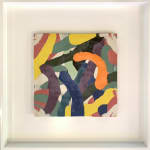


Ludovic Boney
Chaton pressé 5 , 2021
porcelaine / porcelain
12 x 12 "
30.5 x 30.5 cm
30.5 x 30.5 cm
© Ludovic Boney
More images
Quand les chatons des bouleaux tombent sur le sol dans la nature, ils créent des tâches. Les « chatons pressés » ont été faits en porcelaine colorée dans la matière...
Quand les chatons des bouleaux tombent sur le sol dans la nature, ils créent des tâches. Les « chatons pressés » ont été faits en porcelaine colorée dans la matière et mis sous une presse hydraulique pour leur donner la forme d’une tuile.
Il faut mettre ces « chatons pressés » en relation avec l’autre œuvre exposée : « Chatons (plaque miroir) » 2017-2021 qui découle du projet de Ludovic Boney « Sous les chatons". L’œuvre consiste en une suspension qui se déploie au-dessus du visiteur. Ce sont 689 chatons de bouleau (les fleurs du bouleau) en céramique qui forment le plafonnier. De l'intérieur, sous l’installation, c'est un effet de transparence, de légèreté et un mouvement d'ascension qui est perçu.
La confection des chatons de l’exposition a été séparée en plusieurs étapes. Le chaton a d’abord été modélisé par ordinateur et les 40 premiers modèles ont été imprimés à l'aide d'une imprimante 3D. Ces derniers furent ensuite moulés afin de préparer les moules de coulage. Les exemplaires ont été coulés en semi-grès, sablés, un fil de kanthal a été installé, puis ils ont été cuits selon la technique traditionnelle utilisée en céramique. Les chatons ont finalement été peints de différentes couleurs : chrome, doré, magenta, cyan, jaune, orange et vert lime.
_____________
When the birch catkins in nature fall on the ground, they create stains. The "Chatons pressés" were made of porcelain colored in the material and put under a hydraulic press to give them the shape of a tile.
The works « Chatons pressés » are in relation with another work in the exhibition « Chatons (plaque miroir) » 2017-2021 which stems from Ludovic Boney’s project «Sous les chatons. » The work consists of a suspension that unfolds above the visitor. These are 689 birch catkins (the flowers of the birch tree) in ceramic that form the ceiling light. From the inside, under the installation, it is an effect of transparency, lightness and a movement of ascent that is perceived.
The making of the « chatons » for the exhibition was separated into several stages. The « chaton » was first modeled by computer and the first 40 models were printed with a 3D printer. These were then molded to prepare the casting molds. The specimens were cast in semi-sandstone, sanded, a kanthal wire was installed, and then they were fired according to the traditional technique used in ceramics. The "chatons" were finally painted in different colors: chrome, gold, magenta, cyan, yellow, orange and lime green.
Il faut mettre ces « chatons pressés » en relation avec l’autre œuvre exposée : « Chatons (plaque miroir) » 2017-2021 qui découle du projet de Ludovic Boney « Sous les chatons". L’œuvre consiste en une suspension qui se déploie au-dessus du visiteur. Ce sont 689 chatons de bouleau (les fleurs du bouleau) en céramique qui forment le plafonnier. De l'intérieur, sous l’installation, c'est un effet de transparence, de légèreté et un mouvement d'ascension qui est perçu.
La confection des chatons de l’exposition a été séparée en plusieurs étapes. Le chaton a d’abord été modélisé par ordinateur et les 40 premiers modèles ont été imprimés à l'aide d'une imprimante 3D. Ces derniers furent ensuite moulés afin de préparer les moules de coulage. Les exemplaires ont été coulés en semi-grès, sablés, un fil de kanthal a été installé, puis ils ont été cuits selon la technique traditionnelle utilisée en céramique. Les chatons ont finalement été peints de différentes couleurs : chrome, doré, magenta, cyan, jaune, orange et vert lime.
_____________
When the birch catkins in nature fall on the ground, they create stains. The "Chatons pressés" were made of porcelain colored in the material and put under a hydraulic press to give them the shape of a tile.
The works « Chatons pressés » are in relation with another work in the exhibition « Chatons (plaque miroir) » 2017-2021 which stems from Ludovic Boney’s project «Sous les chatons. » The work consists of a suspension that unfolds above the visitor. These are 689 birch catkins (the flowers of the birch tree) in ceramic that form the ceiling light. From the inside, under the installation, it is an effect of transparency, lightness and a movement of ascent that is perceived.
The making of the « chatons » for the exhibition was separated into several stages. The « chaton » was first modeled by computer and the first 40 models were printed with a 3D printer. These were then molded to prepare the casting molds. The specimens were cast in semi-sandstone, sanded, a kanthal wire was installed, and then they were fired according to the traditional technique used in ceramics. The "chatons" were finally painted in different colors: chrome, gold, magenta, cyan, yellow, orange and lime green.



